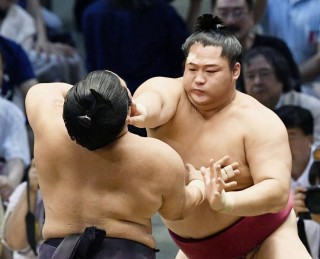Loading
Search
▼ Strength and Tradition Draw Women Back to Sumo World
- Category:Event
So-called スー女 (sūjo, women who are sumo devotees) are on the rise, joining the ranks of 格闘技女子 (kakutōgijoshi, women who go in for martial arts) who have gone mainstream.
Though 相撲 (sumō, sumo) and the culture surrounding it is still off-limits to women, a huge chunk of them are embracing it as never before. And it’s not just the おばちゃん (obachan, middle aged and older women), who had traditionally formed the core of female sumo fans; these days, AKB48 members send out complementary tickets to their favorite 力士 (rikishi, sumo wrestlers), and most of the 幕内 (maku’uchi, top division) wrestlers are rumored to have at least one girl-group member among their ライン友達 (Rain tomodachi, friends on Line). 時代は変わった (Jidai wa kawatta, “Times have changed”).
On a recent Saturday in Tokyo, I saw a 幕下力士 (makushita rikishi, lower-division wrestler) at Shake Shack in 外苑前 (Gaienmae) with a well-groomed young woman at his side, and it should be noted that a) she was the one who stood in a long line to place their orders, and b) she paid. A similar scene had unfolded in a cafe in Marunouchi just before the 九月場所 (kugatsu basho, September tournament). It looks like rikishi, whatever their ranking, are in the flush of an unprecedented モテキ (moteki, a period of being popular and in high demand).
And why not? Today’s rikishi are イケメン (ikemen, handsome dudes) and many are well-spoken, liberal and college-educated. The undisputed 角界の プリンス (kakukai no purinsu, prince of the sumo world) is 遠藤 (Endō, Endo), who’s among a growing number of young wrestlers who prefer to go by their real surnames rather than take on a 四股名 (shikona, wrestler name). Currently at the middle level of the maku’uchi division, Endo is a graduate of Nihon University, as is 石浦 (Ishiura), a hopeful contender among the 十両 (jūryō, middle division) rikishi. The up-and-coming 宇良 (Ura), also a jūryō, is from Kansei Gakuin University, is agile as a gymnast and wears a deep pink まわし (mawashi, loincloth), a color choice that has caused some annoyance among the 親方 (oyakata, elders and stable masters).
Thirty years ago, the majority of wrestlers wavered between the twin 定番 (teiban, standard) mawashi colors of black or rust brown and rarely said anything of interest or ventured beyond the neighborhood perimeters of their 部屋 (heya, stable). Dating was banned and marriages were arranged by the oyakata or 後援会 (kōenkai, support group).
There were exceptions, of course, like the original 貴ノ花 (Takanohana), who dared to elope with the wife of his older brother, former 横綱 (yokozuna, grand champion) Wakanohana, in 1970. At the time, she already had a baby son. Takanohana adopted this nephew, who later became the second 若乃花 (Wakanohana), entering the maku’uchi division around the same time (early 1990s) as Takanohana’s biological son, the second 貴乃花 (Takanohana). The two half-brothers both became yokozuna and created the foundations of the millennial sumo boom. The 若貴兄弟 (Wakataka kyōdai, Wakataka brothers), as they were called, brought a breath of liberal democracy into a sumo world heavily entrenched in tradition and secrecy — by going out in public and actively dating. Takanohana II was briefly engaged to actress Rie Miyazawa before breaking that off and marrying a 女子アナ (joshiana, female TV announcer) eight years his senior. Older bro married a model turned cabin attendant and sired four children before divorcing.
Once close, the brothers are no longer on speaking terms and Wakanohana left sumo to become a TV commentator. Takanohana is a powerful oyakata with his own stable.
All this helped reduce the distance between the sumo world and the modern Japanese woman. Sure, the gender gap still exists, and women aren’t even allowed to touch the rim of the sacred 土俵 (dohyō, sumo ring) or step too close to the 清めの塩 (kiyome no shio, salt for driving away bad luck and evil spirits) that the rikishi all scatter around the dohyō before every bout. But in the years since the antics of the Wakataka brothers, ladies of all ages have been joining the sūjo ranks precisely because of the strict adherence to history and tradition and the drama it brings.
And let’s face it, where else are we going to watch a lot of large, near-naked men wrestle each other on a tiny dirt arena? As my friend Yuki, who’s been a sūjo for most of her life, says: 力士は男らしくて強いのが最高 (Rikishi wa otokorashikute tsuyoi no ga saikō, “The wrestlers are wonderful because they’re manly and strong”), adding that such men are increasingly hard to find in the 日常世界 (nichijōsekai, everyday world).
True, Japanese men have been generally 元気がない (genki ga nai, lacking in cheer) for a long time, unable to impose their values on society and perpetually plagued by a pressure to comply, lose weight and pay higher insurance rates. One pities them, and then one looks to sumo — the total abhorrence of equality, the blissfully ignorant celebration of massive body fat! And it’s conducted among men, only men, and they’re all nearly nude. As women, we have but to watch and sip from beer cans. Sometimes, tradition can be a beautiful thing.
- November 11, 2016
- Comment (0)
- Trackback(0)


